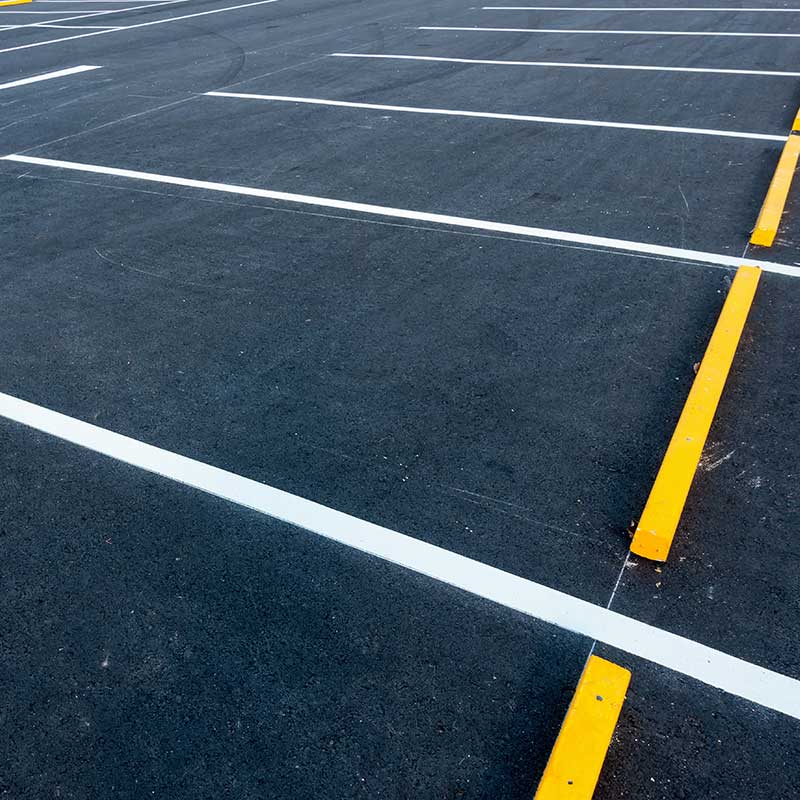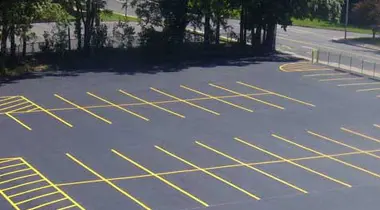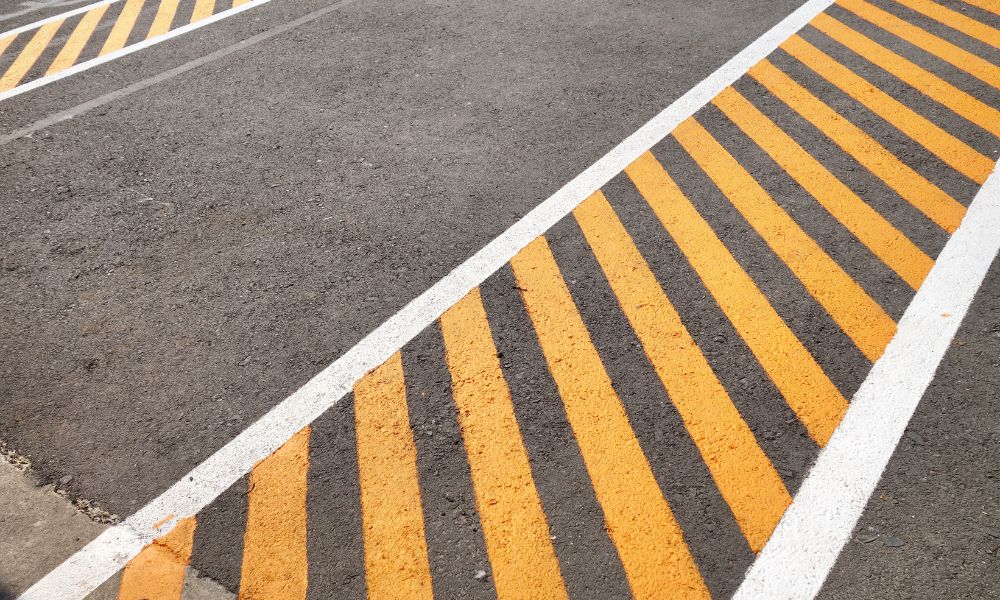Specialist Parking Lot Line Striping to Take Full Advantage Of Place and Improve Accessibility for Your Customers
A Comprehensive Overview to the Ideal Practices in Roadway Paint for Public Freeways
It is important to think about not only the prompt effect of road markings but also their long-lasting maintenance and visibility under varying ecological problems. Recognizing these aspects can substantially influence the effectiveness of road markings, yet many are unaware of the nuances entailed.
Value of Roadway Paint
Roadway paint plays a vital duty in maintaining web traffic safety and efficiency, with studies showing that well-marked streets can minimize mishaps by up to 30%. The clear distinction of lanes, pedestrian crossings, and other vital markings offers to direct motorists and pedestrians, promoting a foreseeable environment when traveling. This predictability is essential for effective navigation and aids minimize complication, which can usually bring about crashes.
Furthermore, roadway markings are instrumental in sharing vital information, such as speed limits and directional advice. They improve visibility, specifically in negative weather or during nighttime driving. The presence of reflective materials in road paints further boosts presence, enabling motorists to determine important markings that affect their actions when driving.

Picking the Right Products
Selecting appropriate products for road painting is vital to accomplishing sturdy and efficient markings. The choice of materials directly affects the visibility, long life, and safety and security of road markings. Common choices include water-based paints, solvent-based paints, and polycarbonate materials, each with distinct buildings and applications.
Water-based paints are eco-friendly, quick-drying, and suitable for most weather condition problems, making them ideal for urban settings. They may need more frequent maintenance due to use and tear. Solvent-based paints, while using exceptional attachment and durability, can pose ecological and wellness issues because of volatile natural substances (VOCs)
Polycarbonate products are increasingly popular as a result of their resilience and lasting performance. These materials are warmed prior to application, permitting for a strong bond with the pavement. Their reflective homes boost presence, especially at night.
When choosing products, variables such as web traffic quantity, environment problems, and the certain type of roadway should be considered. Performing detailed research and consulting with suppliers can help make certain that the selected products fulfill local regulations and requirements, eventually adding to safer streets and enhanced vehicle driver awareness.
Effective Application Methods
Reliable application strategies play an important role in making sure that road markings attain ideal performance and durability. The approach of application considerably affects the bond, exposure, and sturdiness of the markings. High-pressure airless splashing is often liked for its effectiveness and capacity to produce smooth, even lines. This strategy minimizes overspray and ensures that the paint is used evenly, which is necessary for keeping roadway security.
Prior to application, it is crucial to prepare the surface appropriately. This includes cleaning up the road of oil, wetness, and particles to boost bond. Furthermore, temperature and humidity need to be taken into consideration throughout the application process to accomplish the most effective results.
Using the proper devices is additionally crucial. Line stripers furnished with flexible sizes enable for exact markings that satisfy regulative requirements. It is necessary to adjust the tools on a regular basis to guarantee uniformity in paint density.
Timing and Environmental Variables
Appropriate timing and consideration of ecological variables are crucial for the effective application of roadway markings. The performance of roadway paint greatly relies on temperature level, wind, and humidity conditions at the time of application. Ideally, temperatures ought to be in between 50 ° F and 85 ° F(10 ° C to 29 ° C) for optimum attachment and healing. When temperatures are too low, paint might not heal effectively, bring about early wear and reduced exposure.
Moisture levels also play a crucial function; high humidity can hinder drying times, while excessively completely dry problems may cause quick evaporation of solvents, influencing the paint's efficiency. Wind can introduce Discover More Here contaminants and particles, possibly endangering the high quality of the markings. It is suggested to pick tranquil days have a peek at these guys for application.

Scheduling paint jobs throughout positive weather conditions can substantially boost the long life and effectiveness of roadway markings - Line painting company. By carefully examining these elements, firms can guarantee that road markings are used efficiently and maintain their exposure and longevity over time.
Maintenance and Durability Techniques

One efficient technique is to carry out a methodical repainting program based on web traffic volume and environmental aspects - Road painting services. Higher traffic locations might require even more constant upkeep to neutralize the erosive results of cars and climate condition. Additionally, the try this out usage of sturdy products, such as thermoplastic and epoxy paints, can considerably prolong the life expectancy of road markings
Cleansing roadway surface areas to remove particles and pollutants is one more vital facet of upkeep. This ensures optimum adhesion of new paint and boosts the total effectiveness of the markings. Employing advanced technologies, such as computerized tracking systems, can streamline the monitoring process and optimize upkeep timetables.
Including these methods will certainly not only enhance the presence and security of road markings yet additionally decrease long-term prices connected with constant repainting and repair services. (Road painting services)
Final Thought
View Line painting Abbotsford in a full screen map
In recap, implementing best practices in roadway painting is important for enhancing safety and efficiency on public freeways. The choice of appropriate materials, incorporated with effective application strategies and consideration of ecological aspects, adds to the durability and exposure of roadway markings. Regular upkeep and evaluations even more expand the life expectancy of these markings, eventually decreasing mishaps and improving general road functionality. Sticking to these guidelines cultivates more secure driving problems and helps with smoother traffic circulation.
The presence of reflective products in roadway paints even more enhances exposure, allowing drivers to discern essential markings that influence their actions on the road.
Selecting suitable products for road painting is essential to accomplishing resilient and efficient markings.While the initial application of road markings is critical, ongoing upkeep approaches are equally vital to ensure their long life and visibility. Additionally, the usage of resilient products, such as thermoplastic and epoxy paints, can dramatically expand the life expectancy of road markings.
The selection of proper materials, combined with efficient application strategies and consideration of environmental factors, contributes to the toughness and visibility of roadway markings.